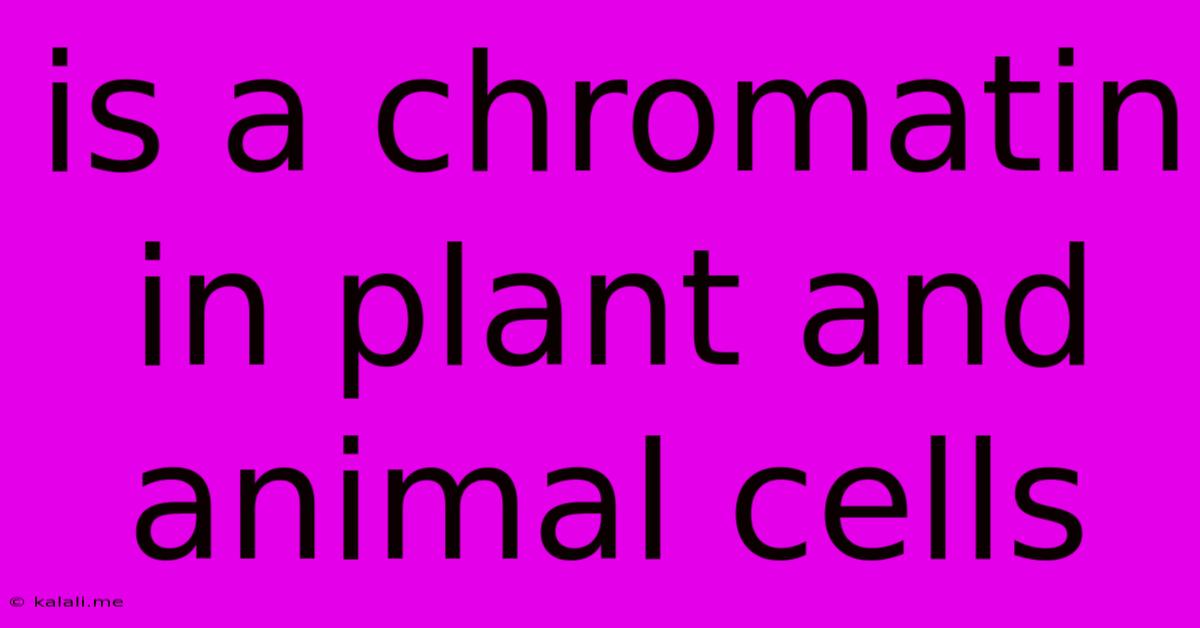Is A Chromatin In Plant And Animal Cells
Kalali
May 10, 2025 · 3 min read

Table of Contents
Is Chromatin Found in Plant and Animal Cells? A Deep Dive into Cell Structure
Meta Description: Discover the crucial role of chromatin in both plant and animal cells. This article explores its structure, function, and the similarities and differences in its presence across these cell types. Learn about the implications of chromatin organization for cellular processes.
Chromatin, the complex of DNA and proteins that makes up chromosomes, is a fundamental component of eukaryotic cells. But is chromatin found in both plant and animal cells? The short answer is a resounding yes. While there are subtle differences in the specifics of chromatin organization and function between plant and animal cells, its presence and essential role in both are undeniable.
This article will delve deeper into the nature of chromatin, its importance in cellular processes, and the nuances of its presence in plant and animal cells.
Understanding Chromatin: The Building Blocks of Chromosomes
Chromatin is not just a passive storage unit for DNA; it's a highly dynamic structure that plays a crucial role in regulating gene expression, DNA replication, and repair. The basic unit of chromatin is the nucleosome, consisting of DNA wrapped around histone proteins. These histones act like spools, organizing the long DNA strands into manageable packages. This packaging is essential because the sheer length of DNA in a single cell is immense.
Think of it like this: Imagine a long string of yarn (DNA). To make it manageable, you wind it around spools (histones). These spools are further organized into higher-order structures, creating a complex network. This intricate organization allows for the efficient storage and regulated access to the genetic information.
Chromatin in Plant Cells: Unique Adaptations
Plant cells, in addition to possessing chromatin, contain unique features that influence chromatin structure and function. For instance, the plant-specific chromatin remodeling complexes contribute to the regulation of genes involved in processes such as photosynthesis and responses to environmental stresses. The presence of a cell wall also presents unique challenges for chromatin organization during cell division.
Plant cells also exhibit specific patterns of chromatin methylation and acetylation, which are crucial epigenetic modifications that influence gene expression. These modifications are often linked to responses to environmental cues like light and temperature, highlighting the adaptability of chromatin in plant cells.
Chromatin in Animal Cells: Complexity and Diversity
Animal cells also contain chromatin, with a similar basic structure to plant cells. However, animal cells exhibit greater diversity in chromatin organization and function, reflecting the wider range of cell types and physiological processes found in animals. For example, specialized chromatin structures are crucial for the development and differentiation of various cell types, ensuring proper gene regulation during the formation of tissues and organs.
Additionally, animal cells possess diverse families of histone proteins and chromatin-remodeling enzymes. These variations contribute to the intricate regulation of gene expression and contribute to the remarkable complexity of animal development and physiology.
Similarities and Differences: A Comparative Perspective
While both plant and animal cells use chromatin as the fundamental unit for packaging their DNA, several distinctions exist:
- Histone variants: Although both utilize core histones, the specific variants and their post-translational modifications differ between the two cell types.
- Chromatin remodeling complexes: While both possess these complexes, the specific composition and functions can vary, reflecting the unique needs of each cell type.
- Epigenetic modifications: Both plant and animal cells use epigenetic modifications, such as DNA methylation and histone modification, but the patterns and functional consequences differ significantly.
Despite these differences, the underlying principle – the packaging of DNA into a manageable and regulatable structure – remains consistent in both.
Conclusion: Chromatin – The Universal Organizer
In conclusion, chromatin is a fundamental component of both plant and animal cells. While specific characteristics of chromatin organization and function vary between these kingdoms, its essential role in DNA packaging, gene regulation, and cellular processes is universal. Understanding the nuances of chromatin in different cell types is crucial for unraveling the complexities of cellular life and advancing our knowledge of biology.
Latest Posts
Latest Posts
-
How Many Weight Watchers Points In 5 Ritz Crackers
Jul 02, 2025
-
1 Lb Of Pasta Is How Many Cups
Jul 02, 2025
-
What Does Lady Gaga Say In French In Bad Romance
Jul 02, 2025
-
How Many Square Yards In One Acre
Jul 02, 2025
-
What Is 2 3 Of 3 Quarts
Jul 02, 2025
Related Post
Thank you for visiting our website which covers about Is A Chromatin In Plant And Animal Cells . We hope the information provided has been useful to you. Feel free to contact us if you have any questions or need further assistance. See you next time and don't miss to bookmark.